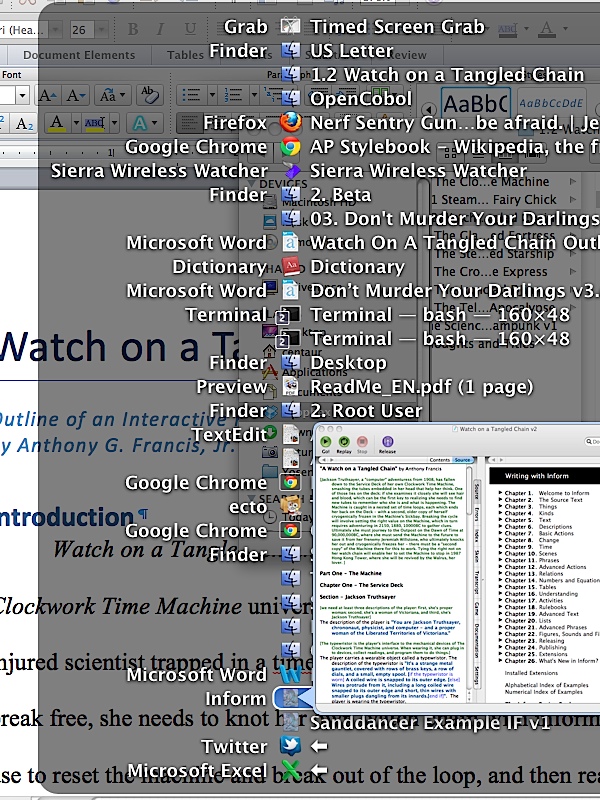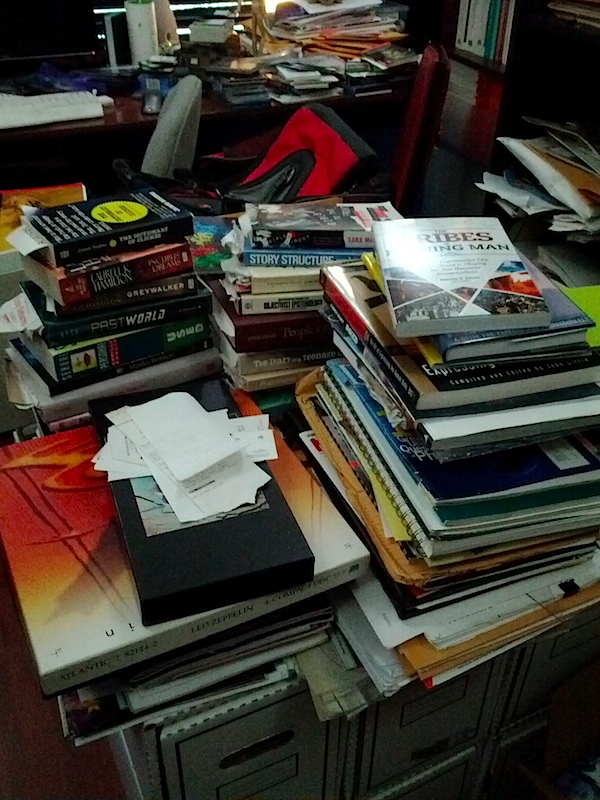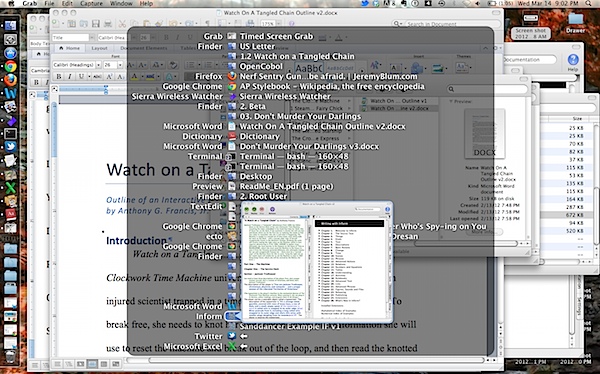Anyone who knows me in detail knows I’m a pile person. You can see the all the windows open above, but that’s not the half of it: I had 14 tabs open in Firefox, 3 windows with 17, 13, and 3 tabs open in Chrome, and ten windows open in Finder, Mac OS X’s file browser. I hammer my operating systems, loading them with as many windows, programs, files and fonts they can take.
But it’s not just operating systems. I’ve got a huge folder of todos in my jacket pocket, a pile of books in my bookbag, on the table, in my car. My library, office, spare office and even kitchen table are filled with piles, as is my desk at work.
On the one hand, this could simply be because I’m a hoarder and need to learn to clean up more, and maybe I do. But most of the piles are thematically organized: in the shot above you can see (slightly overlapping) piles for a young adult and urban fantasy series, an art pile, a pile of bills, CDs being organized, and so on.
Some of this is, again, a product of mess, but the rest of it is a deliberate strategy. A collection of books on a topic serves as an external memory that augments the goo we have in our heads. This is part of the theory of situated cognition, which posits that our memories are elaborated through interaction with the external world.
William Clancey, one of the founders of situated cognition, puts it this way: his knowledge of what to take on a fishing trip isn’t in his internal memory: it’s in his fully stocked tacklebox, which represents the stored wisdom of many, many fishing trips; if he was to lose that tacklebox, he’d lose a portion of his memory, and become less effective.
My toiletry bag for flying serves the same role. Its contents have been refined over dozens, maybe even hundreds of trips. It doesn’t just have a toothbrush and toothpaste, contact lens solution and hairspray, it has soap, shampoo, cough drops, nail clippers, bandaids and more. If I forget it, and try to recreate the toiletries that I need for a trip on the fly, I almost always have to go back to the store.
Situated cognition has been challenged, and I couldn’t find the perfect reference that summarized what Clancey said in the Cognitive Science Brownbag talk I attended at Georgia Tech so many years ago. But I know how I work, and I know how it’s influenced by that framework.
When I’m tackling a project, I build a pile. It might be a pile of tabs in a browser, folders of links in my bookmarks, files in a directory, books from my mammoth library. These serve as references I use to generate the text, the material I use to generate my writing, but they also serve as something more. They serve as a pointer to return me to an old mental state.
If I have to close my browser, reboot my machine, put a project aside, switch to another book, I can keep the pile. I have mammoth collections of files and bookmarks, and a mammoth library with something like 30 bookcases (that’s cases, not shelves). And when I’m ready to reopen the project, I can start work on it again.
I’ve done that recently, restarting both my work on the “Watch on a Tangled Chain” interactive fiction and an exploration of programming languages – one project I hadn’t worked on for a year, and one maybe for several years. But when I found the files, I was able to resume my work almost effortlessly. With physical piles of books, the process is even more joyful, as it involves reading snippets from half a dozen or so books until I’m back into the mindset.
So thank you, my poor processor, my crowded browser, my packed library. You make me more than I am on my own.
-the Centaur


